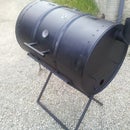Introduction: How to Make a Homemade Pizza Oven
This is a step by step guide on how to build a homemade pizza oven from scratch!! This is a great, relatively cheap project, that will keep you entertained all through the summer and surprisingly, even the winter!! I made it with Darren Lewis and Josh Bagshawe and it always ends up getting lit at every party and actually becomes quite the centre piece!!
As you will discover, as well as making fantastic pizzas, this oven comes into its element when slow cooking large joints of meat! Lovely slow cooked shoulder of lamb, belly pork, beef ribs, pork ribs and even a whole pot of curry! Whatever joint you decide, wrapping it in layers of tin foil will protect it from the fire and keep it tender and succulent!
Happy building! I look forward to seeing what you make! For further designs and projects please check out my website - www.philreillydesigns.com
I am currently working on a new minimalist ballpoint pen and stylus, check it out at: www.529studio.co.uk or follow me on instagram @529studio
All the best,
Phil
Step 1: What You Will Need
We decided to build this pizza oven on a wooden crate so we had the option of moving it if we needed to! Although if you decide to do this, please remember that the construction will probably be about half a tonne so a pallet truck or fork lift will be required! A lot of people find a more permanent location for the oven and build a brick stand for it so the pizza oven is at waist level when stood infront of it.
What you require:
• Sharp sand (general purpose sand usually containing small amounts of aggregate in the mix)
• Builders sand (finer sand that is good for detailed work)
• Cement
• Aggregate
• A bucket or pot for the chimney (Optional!)
• Spade for mixing
• Trowel for brick laying
• Bricks (ideally heat resistant but not essential)
• Large cellophane sheet
• Some old pieces of wood / foam for shaping the arch
• Chipboard (if building on a pallet) - make sure it is for outdoor use otherwise it will warp!
• Wooden pallet
• Drill
• Wood Screws
• Wood Saw
The exact quantities depend on what size you decide to build. You can build this oven in stages so there is no need to know exact quantities when you initially start building. Lots of people say that heat resistant bricks should be used when building an oven. When heated to a high temperature, standard building bricks can expand and cause the oven to crack a little. We have had this oven extremely hot and have not had issues with cracking so a lot if down to personal preference!
Step 2: Creating the Base
After the pallet is sorted, use the wood saw to cut a section of chip-board that exactly fits the base of the pallet. Cut some strips of chipboard that are about 50mm high to form a perimeter around the top of the pallet. make sure that there are no large gaps between the boards as this will form the seal to hold in the concrete!!
Mix the concrete in a 1:2:4 ratio (1 part cement, 2 parts sharp sand, 4 parts aggregate). Use the spade to put the concrete in the wooden mould. You can use a long wooden baton lengthways to ensure that the concrete is flat and has the best finish. This top layer will create the floor for the pizza oven so try and get it as smooth as you can.
Step 3: Arranging the Bricks / Planning Size
Step 4: Creating the Arch
Step 5: Cementing the Bricks in Place
Begin layering up the bricks working up the side of the cellophane sheeting. At this stage it is good to cement in place the chimney. Having the chimney slightly higher than the door ensures that the smoke travels out of the chimney as opposed to just coming out of the front of the oven. Don't worry about the cement looking a bit messy. This will be sorted in the next step.
Step 6: Creating the Concrete Outer Layer
Step 7: Removing the Supports and Sand
Step 8: Creating a Small Fire and Then Cooking Time!!
Happy cooking and I wish you all the best!
p.s if you get your oven hot enough you may even see some pretty flames escaping from the chimney!!





